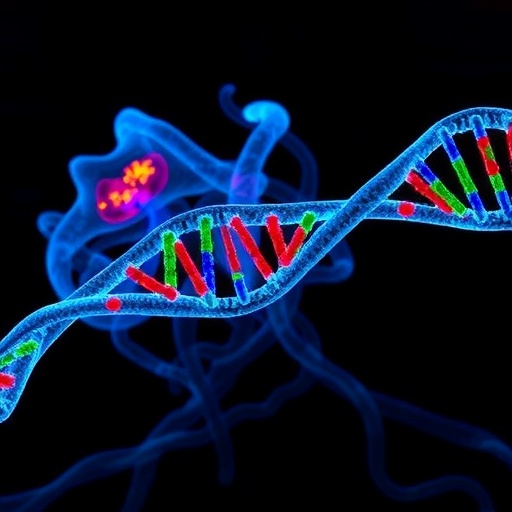In a groundbreaking advance that could revolutionize the diagnosis and treatment of neuroendocrine neoplasms (NENs), researchers have unveiled a novel approach that leverages DNA methylation patterns to accurately trace the origins of these complex tumors. The study, published in Nature Communications, represents a critical step forward in understanding the epigenetic landscapes that define neuroendocrine tumors and sets the stage for more precise clinical interventions.
Neuroendocrine neoplasms are a heterogeneous group of tumors arising from neuroendocrine cells, which are found throughout the body, including the lungs, pancreas, and gastrointestinal tract. These tumors often pose significant diagnostic challenges due to their varied biological behavior and overlapping morphological characteristics. Pinpointing their tissue of origin is crucial for guiding effective treatment strategies and improving patient outcomes, yet conventional diagnostic tools frequently fall short in this regard.
The research team, led by Goeppert et al., concentrated on the distinctive epigenetic signatures imprinted on tumor DNA, specifically focusing on patterns of DNA methylation—a biochemical modification where methyl groups are added to cytosine nucleotides, influencing gene expression without changing the underlying DNA sequence. These methylation marks can act as cellular identifiers, preserving clues about the cell type from which the tumor originated.
Harnessing cutting-edge bioinformatics and high-throughput sequencing technologies, the investigators performed an extensive analysis of DNA methylation profiles across a broad spectrum of neuroendocrine neoplasms. The study encompassed samples from multiple anatomical sites, enabling a comprehensive comparison that illuminated unique methylation landscapes corresponding to distinct tumor origins.
Their analysis revealed that neuroendocrine neoplasms harbor highly specific methylation signatures capable of discriminating between tumors arising in different organs with remarkable accuracy. This epigenetic fingerprinting approach transcends traditional histopathological assessments, which can be prone to ambiguity, especially in metastatic contexts where the primary tumor site is unknown or obscured.
Importantly, the researchers demonstrated the robustness of their methylation-based classifier in clinical samples, showcasing its potential utility in real-world diagnostic scenarios. This was exemplified by accurately assigning the tissue of origin in cases where conventional methods had failed or yielded inconclusive results, underscoring the transformative clinical value of epigenetic profiling.
The implications of this work extend beyond diagnostics. By elucidating the epigenetic architecture underlying neuroendocrine neoplasms, the study opens avenues for exploring targeted epigenetic therapies. Modulating aberrant methylation patterns could pave the way for novel therapeutic interventions tailored specifically to the cellular origin and molecular characteristics of each tumor, thereby enhancing treatment efficacy and minimizing off-target effects.
Furthermore, the researchers’ methodology is emblematic of a broader trend in oncology—leveraging multi-omics and integrative computational approaches to decode the molecular complexity of cancers. The successful application of DNA methylation profiling in this context exemplifies how detailed epigenetic mapping can complement genomic and transcriptomic analyses, ultimately enriching our understanding of tumor biology.
The study also contributes to the growing recognition that epigenetic alterations are not merely supportive players but can act as primary drivers in cancer development and progression. The nuanced methylation patterns characterized in this research underscore the critical role of epigenetic regulation in defining tumor phenotype and behavior, providing fresh perspectives on oncogenesis.
From a technical standpoint, the research team employed sophisticated machine learning algorithms to interpret the vast datasets generated, optimizing classification models that balance sensitivity and specificity. This rigorous computational framework ensured that the predictive power of methylation signatures could be reliably translated into clinically actionable insights.
Notably, the methylation markers identified are stable and detectable using minimal tissue input, facilitating their integration into routine pathological workflows. The potential for developing minimally invasive diagnostic assays, such as liquid biopsies detecting tumor-derived circulating DNA methylation patterns, could further revolutionize patient monitoring and early detection strategies.
Beyond neuroendocrine neoplasms, the principles demonstrated in this study hold immense promise for broader oncological applications. The concept of tracing tumor origin through epigenetic signatures could be adapted to other heterogeneous cancers presenting diagnostic challenges, heralding a new era of precision oncology grounded in epigenetic diagnostics.
As the field moves toward clinical implementation, collaborations between researchers, clinicians, and diagnostic developers will be pivotal to refine and validate these tools across diverse patient populations and tumor subtypes. Prospective clinical trials evaluating the impact of methylation-based diagnostics on treatment decisions and patient outcomes will be essential to confirm the transformative potential of this approach.
In summary, the study by Goeppert and colleagues marks a seminal milestone in cancer epigenetics, offering a powerful new methodology for accurately tracing the origin of neuroendocrine neoplasms through DNA methylation profiling. This innovation is poised to overcome longstanding diagnostic hurdles, enhance personalized therapy, and ultimately improve prognosis for patients battling these challenging tumors.
As the scientific community continues to unravel the complexities of cancer epigenomes, such pioneering research illuminates the path toward integrating epigenetic insights into everyday clinical practice. With further validation and technological advancement, DNA methylation-based tracing could become a cornerstone of modern oncology, enabling clinicians to navigate the intricate biological landscape of neuroendocrine neoplasms with unprecedented clarity.
Continuing to expand on this work, future studies may explore the temporal dynamics of methylation changes during tumor progression and treatment response, offering insights into tumor evolution and potential resistance mechanisms. Understanding these epigenetic shifts over time could inform adaptive therapeutic strategies tailored to individual patient trajectories.
Moreover, combining DNA methylation data with other molecular markers such as genetic mutations, transcriptomic signatures, and proteomic profiles is likely to yield even more comprehensive tumor characterization. Integrative multi-modal approaches could refine diagnostic accuracy and uncover novel biomarkers for early detection, prognosis, and therapeutic targeting.
The promise of epigenetics in oncology is vast, and this study exemplifies how deciphering the methylation code can unlock previously inaccessible dimensions of tumor biology. As research continues to bridge the gap between molecular insights and clinical application, innovations like these underscore the profound impact of epigenetic science on transforming cancer care landscape worldwide.
Subject of Research: DNA methylation patterns and their use in tracing the origin of neuroendocrine neoplasms
Article Title: DNA methylation patterns facilitate tracing the origin of neuroendocrine neoplasms
Article References:
Goeppert, B., Charbel, A., Toth, R. et al. DNA methylation patterns facilitate tracing the origin of neuroendocrine neoplasms. Nat Commun 16, 9477 (2025). https://doi.org/10.1038/s41467-025-65227-8
Image Credits: AI Generated
Tags: advancements in cancer treatment strategiesbioinformatics in cancer researchchallenges in diagnosing neuroendocrine tumorsDNA methylation patternsepigenetic signatures in cancerhigh-throughput sequencing in oncologyimproving patient outcomes in cancermethylation marks as cellular identifiersneuroendocrine neoplasms researchneuroendocrine tumors diagnosisprecision medicine for neuroendocrine tumorstumor origin tracing techniques





